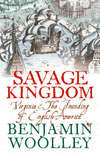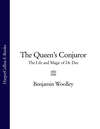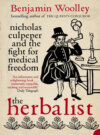Kitabı oku: «Savage Kingdom: Virginia and The Founding of English America»

SAVAGE KINGDOM
Virginia and the Founding
of English America
BENJAMIN WOOLLEY

CONTENTS
Cover
Title Page
Part One
1 A Feast of Flowers and Blood
2 Machiavelli
3 The Adventurers
4 Departure
Part Two
5 Tsenacomoco
6 Soundings
7 The Spanish Ambassador
8 Bloody Flux
9 True Relations
10 The Virginian Sea
Part Three
11 El Dorado
12 The Mermaid
13 Promised Land
14 The Astrologer
15 Devil’s Island
16 Deliverance
Part Four
17 A Pallid Anonymous Creature
18 Strange Fish
19 The Good Husband
20 Twelfth Night
Part Five
21 Imbangala
22 The Treasurer
23 The ‘Viperous Brood’
24 The Unmasked Face
Notes
Bibliography
Index
About the Author
Author’s Note
Copyright
About the Publisher
Part One
ONE A Feast of Flowers and Blood
ON THE MORNING of 20 September 1565, the sixty-year-old carpenter Nicolas le Challeux awoke to the sound of rain pelting down on the palm-leaf thatch overhead. It had not stopped for days, and a muddy morass awaited him outside.
When he had arrived in Florida the previous month, a sunnier prospect had beckoned. He had left the terrors of his native France far behind, and come to a place where he could practise his craft and religion in peace. Its very name suggested renewal, the Spanish explorer Juan Ponce de León calling it Florida after the season in which he first sighted its shores: Easter Week, or Pascua Florida, ‘the feast of flowers’.
Florida could furnish all that a man could wish on earth, Challeux had been told. It had received a particular favour from heaven, suffering neither the snow nor raw frost of the North, nor the drying, burning heat of the South. The soil was so fertile, the forest so full of wild animals, the honest and gentle natives could live off the land without having to cultivate it. There were even reports of unicorns, and of veins of gold in a great mountain range to the north called the ‘Appalatcy’. It was ‘impossible that a man could not find there great pleasure and delight,’ Challeux was assured.1
The contrast with the state of his homeland was stark. Europe was in turmoil. To the south, the Catholic Spanish and Holy Roman empires, offshoots of a single dynasty, domineered. In the north, Queen Elizabeth reigned over Europe’s upstart Protestant monarchy England, while her subjects egged on their co-religionists in the Low Countries (modern Netherlands and Belgium), who were fighting for independence from their Spanish overlords. To the east stretched the Islamic Ottoman Empire, Suleiman the Magnificent resting an elbow upon the Balkans, a heel upon Basra. And in the middle lay France, a Catholic country penetrated by a powerful Protestant or ‘Huguenot’ minority. Exposed to so many religious and political tensions, it threatened to disintegrate, and in 1562, a series of civil wars erupted across the kingdom that were so brutal, they gave the word massacre, French for a butcher’s block, its modern meaning.
It was from the midst of this maelstrom that Gaspard de Coligny, leader of the Huguenots, had dispatched a fleet under the command of his kinsman René de Laudonnière to found a Protestant refuge in Florida. To the eyes of Coligny’s Catholic enemies, this was a provocative move. Though its coastline was still only hazily charted, and some even doubted it was a single land mass, all of North America was claimed by the Spanish under a famous ‘bull’ or edict issued by Pope Alexander VI shortly after Christopher Columbus’s historic expedition of 1492. This had donated all the ‘remote and unknown mainlands and islands’ in the Atlantic to the Iberian kingdoms of Spain and Portugal, so they could bring the native populations ‘to the worship of our Redeemer and profession of the Catholic faith’. By sending his men to Florida, which was within convenient reach of Spanish possessions in Cuba and Mexico, Coligny was clearly challenging not only the Spanish claim, but the religious authority underpinning it.2
However, Coligny’s exiles had found Florida untouched by the Spanish, and settled themselves on the banks of the River of May (now called St John’s River, near modern Jacksonville), on a ‘pleasant open space covered with various kinds of grasses and plants’. They called their new home Fort Caroline, after France’s Catholic King Charles IX, in the hope of forestalling reprisals. Old Challeux had arrived the following year with another consignment of refugees, on a supply ship captained by Jean Ribault, a prominent Huguenot, as well as one of France’s most accomplished seamen.3
Conditions for the newcomers turned out to be less Elysian than advertised. The hundred or so settlers who had been there a year had run out of supplies, and were living off wild fruits, berries, the occasional crocodile, and goods stolen from the local Indians. There were also reports that the Spanish had been tipped off about Coligny’s project, and had sent a fleet which was even now roving the coast.
Over the coming weeks, Challeux joined a team of workmen who, under the direction of John de Hais, master carpenter, tried to reinforce La Caroline’s fragile palisade. The state of the fort’s defences was pitiful. The triangular layout was breached in two places, along the western side, and the long southerly wall facing the river, where the foundations for a ‘grange’ to store the settlement’s artillery and munitions lay partially built.
The weather hampered the workmen’s efforts. Daily deluges washed away the embankment supporting the palisade wall, and intervals of baking sunshine were too fleeting to allow the damage to be repaired. Meanwhile, the surrounding landscape became more and more saturated. Rivers burst their banks, meadows became marshland.
And so, on this September morning, Challeux faced another day of hard labour in the remorseless rain. Nevertheless, he managed to rouse himself, put on a damp and rotting cloak, and gather his tools.
A few hundred yards away, beyond the curtain of incessant rain, Don Pedro de Menéndez de Avilés lay in wait at the head of a column of five hundred soaking, disgruntled but well-armed Spanish troops. Menéndez was a Spanish noble and naval commander. He had arrived in Florida with a fleet of Spanish galleons a few days before Ribault, with orders to exterminate the ‘Lutherans’ and establish himself as Adelantado or governor of Florida, which King Philip II of Spain declared extended all the way from the keys on the southernmost tip of the Florida peninsula to Newfoundland.4
Menéndez had anchored his ships in the River of Dolphins (modern Matanzas River), about thirty-five miles south of Fort Caroline. There, on 28 August, he had set about building a military base, which he called St Augustine, in honour of the feast day upon which construction work had begun. After several weeks gathering intelligence about Fort Caroline from local Indians, and harrying Ribault’s fleet, he decided to mount a land attack on the French settlement.
The journey from St Augustine to Fort Caroline had proved dangerous and tiring. Though led by Francis Jean, a French defector who had lived in Fort Caroline, Menéndez’s troops got lost. They had to make their way through ‘morasses and desert paths never yet trod’, often up to their armpits in water, holding heavy knapsacks, ladders (for scaling the fort’s palisade) and harquebuses (a heavy forerunner to the musket) above their heads. They had finally reached a ‘little rise in the ground’ overlooking Fort Caroline in the early morning of 20 September, ‘the eve of the day of the Blessed Apostle and Evangelist St Matthew’.5
Menéndez commanded his men to stay hidden in the woodland while the camp master, Don Pedro de Valdes, and Francis Jean were sent ahead. They made their way through the thick undergrowth until they found their path blocked by a fallen tree. Turning back, a French sentinel who was patrolling nearby glimpsed them through the thicket. ‘Qui va la? [Who goes there?]’ he called. ‘Un Français [a Frenchman],’ the Spanish captain replied, in a convincing accent. The sentinel approached, and as soon as he was within reach, Valdes drew his sword and slashed him across the face. The sentinel fell backwards, giving a shout.
The cry carried through the thicket of trees, across the waterlogged clearing and turf embankment surrounding the French fort, through the wide gaps of its palisade, reaching the ears of Challeux as he was leaving his quarters. Guards were summoned, and they rushed out to see what had happened, leaving the fort’s gates open behind them.
At the same moment, Menéndez, thinking the cry was from his own camp master, gave the order to attack. Spanish troops burst from the cover of trees and poured through the fort’s still-open gates, firing and slashing at the panicking French settlers, who emerged from their quarters in their nightshirts to see what was going on.
Challeux saw a Spanish pikeman charging at him, and ran to a ladder or scaffold leaning up against one section of the fort’s rampart. ‘Nothing but the grace of God enabled me to double my effort,’ he recalled. ‘Old grey-haired man that I am, I nevertheless jumped over the ramparts, which if I thought about it, I could not have done, for they were eight or nine feet in height.’6
Not until he reached the cover of trees did he dare look back. He beheld ‘the horrible slaughter of our people’. Some managed to reach boats moored along the nearby shore, and row out to Ribault’s fleet, which was anchored in the river. The rest were killed where they stood, the Spanish vying ‘with each other as to who could best cut the throats of our men’. They even attacked the ill, the old, women and children, Challeux claimed, ‘in such a way that it is impossible to conceive of a massacre which could be equal to this one in cruelty and barbarity’.7
Once the savagery had subsided, the corpses were dragged out of the fort and dumped on the river bank. The Spanish soldiers, frustrated that so many had escaped, ‘vented their wrath and bloody cruelty on the dead’, scooping out their victims’ eyeballs, sticking them on the points of their daggers, and hurling them into the river ‘with shrieks of abuse and ribald laughter’.
Challeux fled into the woods, and made his way to the coast. He was picked up by one of Ribault’s ships the next day, and reached France a few weeks later, where he published a sensational account of his experiences. Others, including Jean Ribault, were less fortunate. Caught in a storm, they were shipwrecked back on the Florida coast. Exhausted and starving, they eventually surrendered to the Spanish, who bound them two by two, took them behind a sand dune, and slaughtered them. Only seven were spared, four who claimed to be Catholics, together with a drummer, a fife player and a carpenter, required by Menéndez to supplement his own troops.8
In a report of his actions sent to King Philip, Menéndez boasted, ‘I made war with fire and blood as Governor and Captain General of these Provinces upon all who might have come here to settle and to plant this evil Lutheran sect’. Having ‘come to this coast to burn and hang’ the hated Huguenots, he pledged to continue pursuing them ‘by sea and by land’ until they were annihilated.
To prevent any other adherents of that ‘wicked Lutheran sect’ returning to North America – particularly the English, who he noted had nominated Ribault ‘Captain General of all [their] fleet’ – Menéndez now urged the King to secure the entire eastern coast of North America. In particular, the Spanish should build a fort at the ‘Bahia de Santa Maria’ at thirty-seven degrees of northerly latitude, ‘the key to all the fortifications in this land’. This was the region that would later come to be dubbed by the English ‘Virginia’.9
Even in Spain, Menéndez was denounced for ‘inhumanely condemning so many souls to hell for ever’ at Fort Caroline. But he claimed that such brutality had been necessary. He had prevented the weed of Protestantism which had spread so quickly across the northern parts of Europe, from taking hold in the fertile soil of the New World. The massacre was a godly act, born of ‘divine inspiration, rather than from any dictate of human understanding’. Some even suggested that Menéndez had been merciful, ‘since he nobly and honourably put them to the sword, when by every right he could have burnt them alive’, the preferred punishment for heresy.
King Philip, who saw himself and his mighty empire as custodians of the true faith, reinforced this view. ‘The justice you meted out to the Lutheran corsairs who attempted to occupy and fortify Florida in order to sow the seeds of their wicked sect,’ he informed Menéndez, was ‘fully justified’. In the great battle for the soul of Europe and the future of mankind, North America had become the new front line.10
TWO Machiavelli
ON A COLD JANUARY DAY IN 1606, a messenger walked inconspicuously across the cobbles of London’s Strand, carrying a parcel for delivery to an address opposite the Savoy. It was a journey of only a few hundred yards, but one that crossed from one era of history to another. Just beyond Charing Cross lay York House, where, in 1599, the Earl of Essex, ‘a man of great designs’, had been imprisoned for his attempts to rouse Queen Elizabeth’s hesitant government to a heroic war against the ‘tyranny’ of Catholic Spain. A few yards further on was Durham House, once the home of Sir Walter Raleigh, the swashbuckling adventurer who had tried, and failed, to make North America an English colony, and a beachhead for attacking the Spanish empire. Essex had been executed for his rebellious behaviour in 1601. Raleigh was arrested for treason two years later, and now languished in the Tower of London, his bold schemes mere echoes in the empty halls of his great residence.
Past these mausoleums to old follies and glories lay the messenger’s destination, a brand-new, flat-fronted, perpendicular brick building. At each corner stood a tower, soaring as high as the famous lantern or ‘little turret’ atop Durham House, from which Raleigh had once beheld a ‘prospect which is pleasant perhaps as any in the World’.1 This building was the London residence of Robert Cecil, the Earl of Salisbury, the man who had contrived the downfall of these political giants, shaped the emergence of a new regime under a new king, and cemented his astonishing rise by commissioning the turreted edifice soaring overhead.
The messenger knocked on the door, and was admitted to a small antechamber. Being Secretary of State to King James, and the monarch’s most trusted servant, the Earl was daily assailed by crowds of applicants, supplicants, petitioners and messengers competing for his much divided attention, and the antechamber had been especially set aside to receive them.
A clerk entered the room. He approached the messenger, who handed over the parcel. The clerk broke the wax seal and cursorily glanced at a covering letter, addressed to ‘the Right honourable the Earle of Salisbury of his Majestes privie Councell’. It was from Thomas and Edward Hayes, known to Cecil’s staff as ‘projectors’, agents who tipped off the Secretary of State to speculative schemes that might attract a profit or some political advantage. Attached to the letter was a long, formal document. Its title concerned a controversial subject, and marked it for the Secretary of State’s personal attention. It read: ‘Reasons to move the High Court of Parliament to raise a stock for the maintaining of a colony [in] Virginia’.2
The word ‘Machiavellian’ came into currency in England in the early 1600s, and it was Robert Cecil who in the minds of many personified its meaning. One of the Earl of Essex’s servants, defending his master before a commission of inquiry called following the Earl’s fall from grace in 1599, described the Secretary of State as ‘an atheist, a Machiavel’ who literally embodied the warped morality of political opportunism. ‘It was an unwholesome thing to meet a man in the morning which hath a wry neck, a crooked back or a splay foot,’ said the servant, referring to various deformities with which Cecil had suffered from birth.3
Cecil’s cousin and long-time ally Francis Bacon argued that it was these deformities that conferred upon the Secretary of State the callousness and determination a great political operator needs, making him ‘void of natural affection’, and mindful ‘to watch and observe the weakness of others’.4 These were certainly the qualities he had displayed in his dealings with Sir Walter Raleigh.
Raleigh had been one of Queen Elizabeth’s most cherished, if exasperating, favourites, and in 1584, to demonstrate her affections, she had granted him an exclusive licence to colonize North America. His efforts had resulted in establishing a small settlement on the island of Roanoke, on the Carolina Banks. On this basis he claimed the entire region for the English Crown, naming it ‘Virginia’ in honour of the Virgin Queen. But hostilities with Spain had prevented him from sending supply ships to service the fledgling colony, and in 1590, it was found abandoned, the only clue to the inhabitants’ whereabouts being a word carved in one of the fort’s wooden posts: ‘Croatoan’, the name of a local tribe. Attempts to find the missing settlers came to nothing, and the supply ship had returned to England.5
Even after 1591, when his licence officially expired, Raleigh had continued to claim Virginia as his, on the basis that his Roanoke settlers may have survived, and established a permanent base elsewhere in the region. But several follow-up missions sent to find his ‘lost colonists’ had proved fruitless. In 1602, a rival mission was dispatched to ‘Norumbega’, in the area of modern-day New England, to find alternative locations for an English colony. Raleigh knew nothing of it until it returned with a lucrative cargo of cedar wood and sassafras (an aromatic bark used to fumigate bedlinen and treat syphilis). His fury at a flagrant attempt to challenge his monopoly over North America resulted in an attempt to confiscate the goods, and an appeal for help and support from his ‘friend’ Cecil. ‘I shall yet live to see [Virginia] an English nation,’ he had promised. But his letter coincided with the final days of Queen Elizabeth’s reign, and Raleigh was emerging as an obstacle to Cecil’s complex manoeuvres to ensure the succession of James VI of Scotland to the English throne.
Elizabeth had died on 24 March 1603, and within days the Scots King took her place as James I of England. Soon after, Cecil confronted Raleigh with accusations that he had attempted to plot against the succession, and had him arrested. Sir Walter was tried for treason, sentenced to death, and thrown in the Tower to await his fate, leaving Virginia conveniently available for the new regime to dispose of as it saw fit.
And now Cecil had in his hands this new proposal for ‘the maintaining of a colony in Virginia’. Thomas and Edward Hayes began in a suitably humble tone: ‘Pardon us (right Honourable), that we presume to move this project presented herewith unto you, so remote from the course of your great affairs as America is from England.’ These ‘great affairs’ were the knock-on effects of the Gunpowder Plot, an attempt by a group of disaffected Catholic gentlemen to blow up the House of Commons on 5 November 1605, the day the King and his entire Privy Council, together with most of the English nobility, had assembled at Westminster for the start of a new session of Parliament. Cecil was leading the official investigation into the plot, which was conveniently sweeping up a great many opponents of the new regime.
In their proposal, the Hayeses argued that ‘so great a business’ as colonizing America ‘can never ever be duly effected by private means’, as previous experience had shown. So they and certain associates had ‘devised another way, where by the cause may be completely set forward’: a great public scheme performed under the auspices of Parliament.6
Attached to the letter was the motion they intended to be set before the Houses of Parliament. It proposed setting up a large fleet of modern, well-armed and well-equipped ships manned by ‘able Mariners, and worthy chieftains’, which would be sent across the Atlantic to conquer North America in the King’s name. It would be publicly financed, as ‘private purses are cold comfort to adventurers and have ever been found fatal to all enterprises hereunto undertaken by the English, by reason of delays, jealousies and unwillingness to back that project which succeeded not in the first attempt’.
A model for such an undertaking could be found, the Hayeses believed, in the Low Countries. This collection of mostly Protestant city states, dominions of the Spanish Crown fighting for their independence, had created Europe’s most advanced trading region. They had ‘effected marvellous matters in traffic [trade] and navigation in few years’ by financing their expeditions through the issue of ‘main’ or public stock. In contrast, the English strategy of giving a grandee such as Raleigh a monopoly of trade with a particular region had resulted in failure. ‘It is honourable for a state rather to back an exploit by public consent than by private monopoly,’ the Hayeses concluded.
They therefore proposed that the King should give his assent to an Act of Parliament to authorize the setting up of a public company to colonize America. This was a matter of urgency, as ‘the want of our fresh and present supply of our discoveries [in Virginia] hath in manner taken away the title which the law of nations giveth us’ – in other words, use it or lose it.
Cecil was aware of the urgency, as well as the economic advantages, of a colonial venture. Spain’s enormous wealth, after all, rested upon her speculative ventures in South America, which were now profiting the new Spanish King Philip III to the tune of two million ducats a year – more than twice James’s entire annual income.7 Cecil was also aware of the growing success of London’s trading companies – indeed, James to a degree was coming to depend upon it, as the profits generated by these companies were helping to bankroll his overstretched royal exchequer. The newest, the East India Company, had been founded in 1600 by Sir Thomas Smythe, a close friend and generous supporter of the Crown. It had already sent several ships loaded with bullion to the Far East to buy spices and other exotic goods direct from suppliers. The sale of these items back in England was not only proving highly profitable, but suggested a lucrative new stream of customs revenue for the Crown.
However, the Hayeses had badly miscalculated. There was no way Cecil would countenance a public colonization venture, whatever the trade benefits. The very name ‘Virginia’ was a reminder why he considered this impossible. During the 1570s and ’80s, he and his father Lord Burghley had worked strenuously to marry Elizabeth off to one of Europe’s Catholic princes, so she could produce an heir. They had been fought all the way by a group of courtiers who opposed any such match on the grounds that she and therefore her kingdom would come under the sway of Catholic regimes they saw as tyrannical. It was this clique, egged on by Huguenot exiles wanting to avenge the massacre in Florida, that had promoted the cult of Elizabeth’s virginity. It became an emblem of Protestant purity and independence, which Raleigh had reinforced with his choice of name for English America.
Cecil had since managed to repair some of the diplomatic damage caused by these struggles, his efforts culminating with the Somerset House Peace Treaty with Spain, which was signed in 1604, a year after James ascended to the throne. But this had done nothing to diminish Virginia’s political potency. Just a few months before Cecil received the Hayeses’ proposal, a play called Eastward Hoe had been staged at the popular Blackfriars Theatre. It featured a dissolute ‘thirty-pound knight’ (a reference to King James selling off titles to raise ready cash) who had attempted to mount an expedition to the colony. ‘Virginia longs till we share the rest of her maidenhead,’ the expedition captain had boasted, in an effort to lure footloose and unemployed mariners into joining the mission. ‘You shall live freely there,’ he added, ‘without sergeants, or courtiers, or lawyers, or intelligencers’, the apparatus of oppressive government.
The play’s authors were arrested for such incendiary lines, and even now, one of them, Ben Jonson, was sending Cecil plaintive letters, begging for his freedom. In such circumstances, the idea of a royally endorsed public venture could not possibly be countenanced.8
A private venture, on the other hand – that was a different matter, and a proposal for one just happened to be at hand. Cecil’s factotum, Sir Walter Cope, had long held an interest in foreign exploration, and around the same time as the Hayeses, had sent Cecil a private note suggesting a very different venture. Judge Sir John Popham, another prominent member of James’s government, ‘foreseeing in the experience of his place’ as King James’s Chief Justice ‘the infinite numbers of cashiered captains and soldiers, or poor artisans that would & cannot work, and of idle vagrants that may & will not work, is affectionately bent to the plantation of Virginia’. Cope proposed that a select group of trusted merchants and nobles be approached to fund a small, secret exploratory mission to America to trade with the Indians and search for valuable commodities. All that was required from Cecil was ‘two lines from your Lordship in particular, or from the Lords’ of the Privy Council in support of the venture, and an expedition would be under way in no time.9
This was far more to Cecil’s liking. For all its negative political associations, there was something about Virginia that not even Cecil could completely resist. Raleigh’s geographer, the cleric and colonial propagandist Richard Hakluyt, had since 1599 adopted Cecil as a patron, and on his new master’s behalf uncovered several convincing reports referring to the existence of gold deposits in the ‘Appalatcy’ or Appalachian Mountains to the west of Roanoke. There were also references to a great salt-water lake lying somewhere to the northwest, which could be reached by river, suggesting there might be a route through the middle of North America to the Pacific – the long-cherished dream of a navigable westerly passage to Cathay and the riches of the Orient. Also, intelligence had revealed that, despite these reports, the Spanish had continued to ignore the areas of America north of Florida.10
Cecil was in desperate need of new sources of revenue, not least to cover the cost of glorifying his London residence, which, he admitted to a friend, had ‘almost undone me’. Furthermore, to secure his throne, James had been forced to spend heavily on securing the necessary political support among England’s anti-Scottish elite, and the royal exchequer was already stretched to breaking point. Any venture that had the potential for private profit and royal revenue could not be ignored.11
Nothing more was heard of the Hayeses’ scheme. But within a few weeks of Cope’s letter arriving at Cecil House, the King had been presented with a royal charter to launch a new Virginia venture as a private enterprise, enveloped in secrecy.












